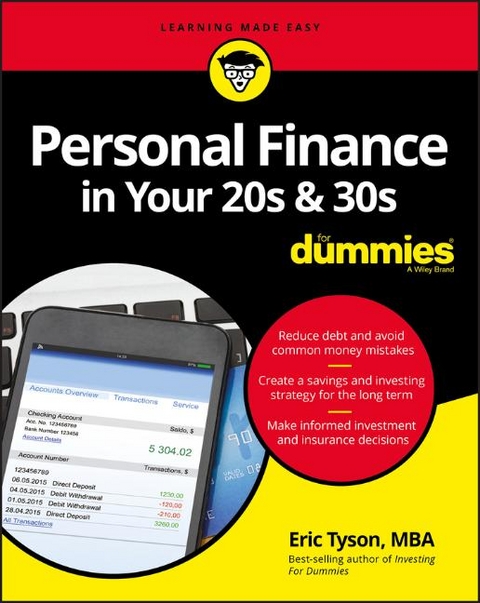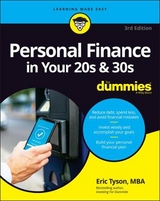
Personal Finance in Your 20s & 30s For Dummies
John Wiley & Sons Inc (Verlag)
978-1-119-43141-1 (ISBN)
- Titel erscheint in neuer Auflage
- Artikel merken
Millennials often confront greater difficulties?including economic uncertainty and student debt?than those who came before them. This new financial responsibility can be intimidating, and many people are unsure where to begin. Personal Finance in Your 20s & 30s For Dummies will help Millennials to be confident about managing their finances and get on a clear path toward financial security.
Inside, trusted financial advisor Eric Tyson shows students and recent grads how to make smart financial decisions in order to pay off student loans, avoid any additional debt, and create a solid plan to ensure their financial success. From avoiding common money mistakes to making informed investment choices, Personal Finance in Your 20s & 30s For Dummies covers it all!
Build a foundation through smart spending and saving
Rent, buy, or sell a house
File taxes the right way
Protect your finances and identity in the digital world
Get ready to forge your own path to financial security!
Eric Tyson, MBA, is an internationally acclaimed and bestselling personal finance author, counselor, and writer. He is the author of five national best-selling financial books including Investing For Dummies, Personal Finance For Dummies, and Home Buying Kit For Dummies. He has appeared on NBC's Today Show, ABC, CNBC, FOX News, PBS, and CNN.
Introduction 1
About This Book 1
Foolish Assumptions 2
Icons Used in This Book 3
Beyond the Book 3
Where to Go from Here 3
Part 1: Getting Started with Personal Finance 5
Chapter 1: Your Financial Checkup 7
Calculating Your Financial Worth 8
Defining net worth 8
Figuring what you own: Financial assets 8
Determining what you owe: Financial liabilities 9
Netting the difference 10
Grasping the Importance of Savings 10
Netting your income and spending 10
Assessing the change in your net worth 11
Understanding and Improving Your Credit Score 12
Deciphering how lenders use credit reports and scores 12
Obtaining your credit reports and fixing errors 13
Getting your credit score 14
Improving your credit reports and score 15
Comprehending Your Investment Options 15
Examining Insurance Coverage 17
Identifying Common Financial Mistakes Young Adults Make 17
Chapter 2: Budgeting, Goal Setting, and Valuing Saving 21
Developing a Savings Mind-Set 22
What It’s Worth: Valuing Savings over Time 24
The difference of continual savings 24
The difference a few percentage points on your return makes to your investment 25
Budgeting and Boosting Your Savings 25
Setting and Prioritizing Your Savings Goals 27
Identifying common goals of accomplished savers 27
Valuing retirement accounts 28
Dealing with competing goals 30
Saving When You’re Strapped 30
Chapter 3: Using Loans and Paying Down Debts 31
Eyeing the Causes of Generational Debt 31
Making the Most of Loans 32
Dealing With Student-Loan Debt 33
Tracking your student loans and making timely payments 33
Prioritizing the payback of student loans 34
Using education tax breaks 35
Weighing the costs and benefits of education expenditures 36
Making the most of student loans, grants, and other financial aid 37
Benefits for military people 38
Working Off Consumer Debt 38
Kicking the credit-card habit 39
Discovering debit cards: Convenience without credit temptation 39
Lowering the interest rate on consumer debt 40
Negotiating better rates from your current credit card 41
Tapping investments to reduce consumer debt 41
Paying down balances 42
Getting Help for Extreme Debt 43
Seeking counseling 43
Considering bankruptcy 44
Preventing Consumer Debt Relapses 47
Chapter 4: Everything Credit: Scores and Reports 49
A Primer on Credit Reports and Credit Scores 49
Differentiating between credit reports and credit scores 50
Understanding how credit scores are determined 51
Knowing the value of a good credit score 52
Jump-starting your credit score as a young adult 52
Getting Your Hands on Your Credit Reports and Scores 53
Recommended websites for free credit scores 54
Websites to avoid 54
Scrutinizing Your Credit Reports to Improve Them 55
Identifying errors and getting them fixed 55
Boosting your credit score 56
Preventing Identity Theft 57
Part 2: Saving and Earning More 61
Chapter 5: Proven Ways to Spend Less and Save More 63
Containing Housing Costs 63
Reducing rental costs 64
Slicing homeowner expenses 66
Cutting Your Taxes 67
Managing Food Costs 68
Trimming Transportation Expenses 69
Finessing Fashion Finances 71
Relaxing on a Budget 72
Taming Technology Spending 74
Keeping Down Insurance Costs 76
Getting Professional Advice 76
Handling Healthcare Expenses 77
Chapter 6: Taxes: Reduce Them or Else! 79
Understanding Taxable Income 79
Comparing Marginal Taxes 80
Reducing Taxes on Work Income 83
Contributing to retirement plans 83
Using health savings accounts 85
Deducting self-employment expenses 86
Increasing Your Deductions 87
Lowering Investment Income Taxes 88
Investing in tax-free money market funds and bonds 89
Selecting other tax-friendly investments 89
Making your profits long term 90
Enlisting Education Tax Breaks 90
Preparing Your Tax Return and Minimizing Your Taxes 91
Chapter 7: Housing: Comparing Renting and Buying 93
The Ins and Outs of Renting 93
Seeing the benefits of renting 94
Considering the long-term costs of renting 94
Completing your rental application 95
Figuring the Costs of Owning and Making It Happen Financially 96
Deciding to buy 96
Comparing the costs of owning versus renting 96
Considering your overall financial health 99
Calculating how much you can borrow 99
Accumulating your down payment 100
Finding the Right Property 100
Points to research 101
Working with Real-Estate Agents 103
Financing Your Home 104
Understanding your mortgage options 104
Deciding which mortgage type is best for you 105
Avoiding negative amortization and interest-only loans 106
Getting your mortgage approved 107
Putting Your Deal Together 108
Chapter 8: Relationships and Money 109
Handling Roommates 109
Living-Together Contracts 111
Getting Married 112
Understanding Your Money Beliefs and Practices 114
Examining your money history 115
Exploring your attitudes toward money 116
Understanding your friends and money 117
Making sense of your environment and money 117
Getting a Grip on Procrastination Where Money is Concerned 118
Diagnosing procrastination 118
Coming to terms with why you may procrastinate with money issues 119
Overcoming money avoidance 120
Chapter 9: Making the Most of Your Career 125
Getting Your Career Going 125
Putting everything in order 125
Educating and training your way to career success 126
Seeking value for your education dollars 127
Investing in your career 130
Exploring Entrepreneurial Options 131
Starting a small business 131
Purchasing a small business 132
Investing in a small business 132
Changing Jobs or Careers 133
The Young and the Unemployed 134
Understanding how joblessness can hit younger adults harder 134
Accessing unemployment benefits 135
Taking action 135
Part 3: Investing for Your Future Goals 137
Chapter 10: Successful Investing Principles 139
Understanding Investments 139
Examining bonds and other lending investments 139
Exploring stocks, real estate, and small-business investments 141
Getting a Handle on Investment Risks 148
Establishing goals and risks 149
Comparing the risks of stocks and bonds 149
Spreading Your Investment Risks 151
Understanding why diversification is key 152
Allocating your assets 152
Holding onto your investments and shunning the herd 153
Selecting an Investment Firm 154
Evaluating Pundits and Experts 155
Chapter 11: Making the Best Use of Bank Accounts 157
Identifying Your Options 157
Brick-and-mortar banks 158
Online banks 158
Other choices 159
Understanding Your Bank Account Options 159
Transaction accounts 159
Options for getting cash 160
Savings accounts 161
Banking Online 161
Evaluating a bank: What to look for 161
Protecting yourself online 163
Considering Your Alternatives 164
Brokerage accounts with check writing 165
Money market funds 165
Chapter 12: Portfolios for a Purpose 167
Before You Begin Investing 167
Investing Nonretirement Account Money 168
Emergency money 168
Long-term money 169
Investing Retirement Account Money 172
Establishing and prioritizing retirement contributions 173
Allocating money in employer plans 173
Designating money in plans you design 175
Investing for Education 177
Understanding the importance of applying for financial aid 177
Paying for educational costs 180
Chapter 13: Real-Estate Investing 183
Understanding Real-Estate Investment Pros and Cons 183
Evaluating Simpler Real-Estate Investments 186
Assessing Residential Housing Investments 187
Investing in Commercial Real Estate 188
Shunning Sure-to-Lose Real-Estate Investments 189
Researching Where and What to Buy 191
Considering economic issues 191
Taking a look at the real-estate market 192
Examining property valuation and financial projections 193
Digging for a Good Deal 195
Part 4: Insurance: Protect Yourself, Your Loved Ones, and Your Assets 199
Chapter 14: The Lowdown on Health Insurance 201
Making Sure You’re Covered 202
Transitioning your coverage 202
Seeing how the 2010 healthcare laws (Obamacare) changed your coverage 203
Trumpcare? 204
Finding Your Best Health Plan 205
Selection of doctors and hospitals 205
Plan benefits and features 205
Shopping for Health Insurance 206
Uncovering the best policies 206
Handling insurance rejection 207
Health Savings Accounts: Tax Reduction for Healthcare Costs 209
Chapter 15: Safeguarding Your Income 211
Protecting Your Income for You and Yours: Disability Insurance 211
Understanding disability coverage you may already have 212
Determining how much disability insurance you need 213
Identifying useful disability policy features 213
Shopping for coverage 214
Protecting Your Income for Dependents: Life Insurance 215
Assessing your current life insurance coverage 215
Determining how much life insurance to buy 216
Deciding what type of life insurance to buy 216
Shopping for life insurance 217
Caring for Your Loved Ones: “Peace of Mind” Insurance 219
Chapter 16: Home, Auto, Renters, and Other Insurance Policies 221
Protecting Your Home and Possessions: Homeowners and Renters Insurance 222
Dwelling coverage 222
Personal property protection 223
Liability insurance 223
Natural disaster protection 223
Shopping for homeowners insurance 224
Insuring Your Car 227
Liability protection 227
Collision and comprehensive 228
Riders you should bypass 229
Getting a good buy 229
Part 5: Your Information Diet 231
Chapter 17: Using Media Resources 233
Going Online: The Wild West of Advice and Predictions 234
Eyeing the real cost of “free” 234
Being aware online 235
Using the web for gathering information 236
Getting Financial Perspectives and Advice from the Media 238
Being a smart news consumer 238
Separating the best from the rest 239
Trusting unnamed “sources” is a bad idea 240
Understanding that political partisans are hazardous to your wealth 242
Chapter 18: Professionals You Hire 243
Seeing the Value of Professional Advice 243
Considering Financial Advisors 244
Preparing to hire a financial advisor 244
Finding good financial advisors 245
Interviewing advisors 246
Taming Your Taxes with Help 248
Working with Real-Estate Agents 249
Using Online Resources to Find Service Providers 251
Angie’s List 251
HomeAdvisor 252
Other resources 253
Part 6: The Part of Tens 255
Chapter 19: Ten Ways to Save on a Car 257
Don’t Buy a Car in the First Place 257
Pay Cash: Shun Leasing and Borrowing 258
Consider Total Costs 259
Compare New with Used 259
Understand a Car’s Real Value Before Negotiating 259
Take Care of Your Car 260
Explore Your Servicing Options 260
Drive Safely 261
Take a Lean and Mean Insurance Policy 261
Track Tax-Deductible Auto Expenses 261
Chapter 20: Ten Things to Value More Than Your Money 263
Investing in Your Health 263
Staying active and at a healthy weight 264
Using fitness trackers to monitor your activity level 264
Making and Keeping Friends 265
Appreciating What You Have 266
Minding Your Reputation 266
Continuing Education 266
Having Fun 266
Putting Your Family First 267
Knowing Your Neighbors 267
Volunteering and Donating 268
Caring for Kids 268
Chapter 21: Nearly Ten Things to Know About Apps 269
You May Well Get What You Paid for with “Free” Apps 270
Conduct and Manage Financial Tasks 270
Use Apps Only from Legitimate Companies with Lengthy Track Records 271
Consider the Alternatives to an App 271
Keep Focused on Your Spending 271
Settle up with Friends but Beware Fees 272
Save Money on Commonly Purchased Items 272
Tap Into the Latest Economic and Financial Data 273
Invest With Confidence 274
Investing in Your 20s & 30s For Dummies 275
Bonus: Investing in Funds: Mutual Funds and Exchange-Traded Funds 277
Understanding the Advantages of Funds 278
Maximizing Your Chances for Fund Investing Success 280
Understanding the importance of performance and risk 280
Examining fund management experience 281
Keeping costs down 281
Understanding and using index funds 282
Understanding exchange-traded funds: Index funds that trade 283
Creating and Managing a Fund Portfolio 284
Identifying the Best Mutual Funds and ETFs 286
Investing in the best ETFs 286
Picking the best stock funds 288
Balancing your act: Funds that combine stocks and bonds 290
Finding the best bond funds 291
Considering Alternatives to Investing in Funds 296
Your own online fund 296
Unit investment trusts 297
Brokerage managed accounts 297
Hedge funds for the wealthier 298
Index 299
| Erscheinungsdatum | 30.01.2018 |
|---|---|
| Verlagsort | New York |
| Sprache | englisch |
| Maße | 190 x 239 mm |
| Gewicht | 472 g |
| Themenwelt | Sachbuch/Ratgeber ► Beruf / Finanzen / Recht / Wirtschaft ► Geld / Bank / Börse |
| Wirtschaft ► Betriebswirtschaft / Management | |
| ISBN-10 | 1-119-43141-7 / 1119431417 |
| ISBN-13 | 978-1-119-43141-1 / 9781119431411 |
| Zustand | Neuware |
| Haben Sie eine Frage zum Produkt? |
aus dem Bereich



